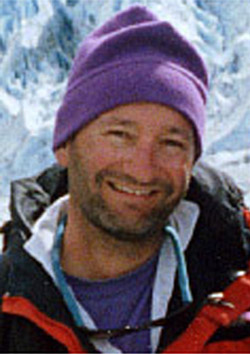John Flinn writes a weekly column and feature articles for the award-winning San Francisco Chronicle travel section. He’s journeyed on assignment to more than 20 countries, including Bhutan, Cuba, the Cook Islands and Croatia, and written more than 400 travel articles. Prior to his job at the Chronicle, Flinn was a feature writer for the San Francisco Examiner, where he was paid to, among other things, fly with the Blue Angels, climb El Capitan, wrestle a bear and go on a date with Miss America.
How did you get started traveling?
From my mid-teens on I was obsessed with mountains and mountain climbing. I started traveling to visit the great ranges of the world, from Yosemite and the Sierra Nevada, to the North Cascades and Tetons, the Alps, New Zealand’s Southern Alps and finally the Himalayas. Eventually I discovered that I liked traveling to the mountains more than I liked climbing them, and I began to travel with the same passion I once devoted to climbing.
How did you get started writing?
My senior year in high school we had a choice of English electives: English Lit or journalism. I signed up for the latter only because of a fear of Shakespeare. To my great surprise I liked journalism and even had had a little talent for it.
What do you consider your first “break” as a travel writer?
I’d been working for the old San Francisco Examiner for 15 years covering three-alarm warehouse fires and working my way up to Sunday features when the travel editor, Don George, resigned. (He’s now at Lonely Planet.) Pretty much everyone on the paper applied for his job, and it came down to me and the assistant business editor. We’d both taken a year’s leave of absence: He went off to Columbia University to study important journalism issues and I vagabonded around the world with a backpack. That’s ultimately what got me my dream job.
As a traveler and fact/story gatherer, what is your biggest challenge on the road?
Usually I have to come up with an 1,800-word cover story for every three or four days I spend on the road — including travel time — which means I’m often just parachuting into a destination, rounding up the necessary information as quickly as possible and moving on. There’s rarely time for the important hanging-out process, which leads to all sorts of serendipity.
What is your biggest challenge in the research and writing process?
Just carving out the time to write. My main duties are as an editor and department manager, and it’s hard to set aside more than one day a week to write.
What is the biggest challenge from a business standpoint, both as a writer and an editor?
Circulation and revenues are down throughout the newspaper industry, which translates into less space to print stories and less money to buy them.
Have you ever done other work to make ends meet?
Just once. Years ago, during a newspaper strike, I agreed to write a short backgrounder about inkjet printers for Hewlett-Packard. It required one half-hour phone interview and about 45 minutes of writing. They paid me almost double my weekly newspaper salary at the time and begged me to do more. It was a reminder that business writing pays an order of magnitude more than journalism or travel writing.
What travel authors or books might you recommend and/or have influenced you?
Tim Cahill invented modern adventure writing and has influenced my writing tremendously. Bill Bryson showed me how to use humor to make serious points (and also make dull travelogues fun to read). Paul Theroux demonstrated how to use the techniques of a novelist in travel writing, and Tony Horwitz brought a journalist’s sensibility to the genre. Jan Morris is the goddess of travel writing, but there’s nothing I can learn from her. It’s like a novice trying to learn to play the saxophone by listening to John Coltrane records.
As an editor, what do you look for in a travel story or essay?
A fresh and compelling angle. Insight and context. Good structure. Good storytelling. When I pick up a manuscript it has to pass this test: Would I read this if I didn’t have to?
What advice and/or warnings would you give to someone who is considering going into travel writing?
It’s not about the traveling, it’s about the writing. Editors are looking for writers who dabble in travel rather than travelers who dabble in writing. Plop Pico Iyer down at a Stuckey’s on the Jersey Turnpike and I guarantee he’ll come back with a great story. On the other hand, a dozen men have walked on the moon and not one has written anything worth reading about it. Also, strive to be a writer, not a travel writer. All the authors I cite above have extensive experience doing other kinds of writing, and that’s what makes them so good. Travel writing can be a pretty claustrophobic genre.
What is the biggest reward of life as a travel writer and editor?
As Paul Theroux once said, it’s not a great living, but it’s a great life. (Although for him it’s obviously both.)

